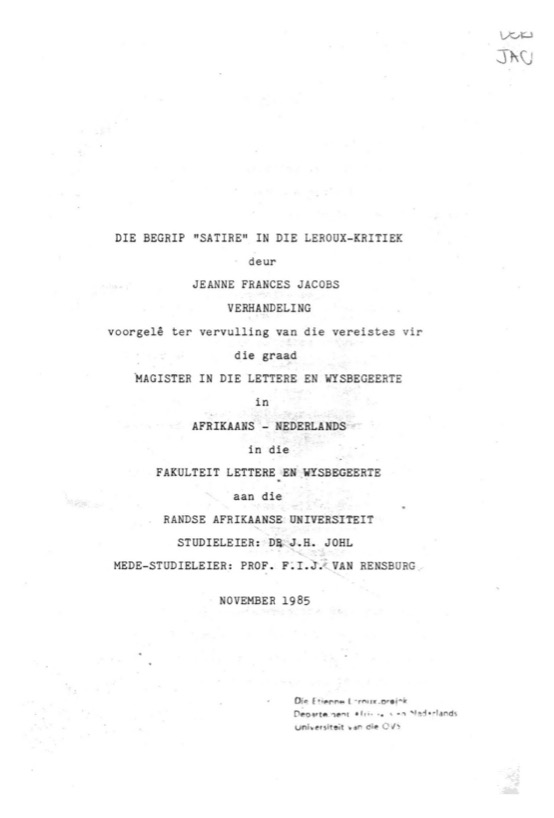-
Title
-
Die begrip "satire" in die Leroux-kritiek
-
author
-
Jacobs, Jeanne Frances
-
datePublished
-
1985
-
degree
-
Magister in die Lettere en Wysbegeerte
-
publisher
-
Randse Afrikaanse Universiteit
-
department
-
Afrikaans - Nederlands
-
contributor
-
Johl, J. H.
-
Van Rensburg, F. I. J.
-
description
-
The goal with this study is to obtain clarity about critics' views of the concept "satire", as it appears in Etienne Leroux's body of works. A study of discussions/studies/reviews reveals an awareness throughout that satire is indeed present. However, when such discussions, etc. are analysed, it becomes obvious that, besides an awareness of the presence of satire in the novels, there is a lack of definition and general vagueness regarding the concept, also in its relation to related phenomena, such as irony, parody, etc. A study of the concept "satire" reveals many different definitions and explanations of it, but that certain essential elements of satire can indeed be distinguished. The satirist attacks certain evils or follies in a critical way by using a variety of techniques, which always contain humour as an element. The aim of the attack implies reform of the evils or follies. The wide spectrum that the tonality and the purpose of the satire can comprise, is closely connected with the techniques the satirist uses. The negative aspect of the attack presupposes a positive contrast or norm. The satirist weapons or techniques can, in general, be divided into four broad categories, viz. those containing an element of incongruence, those springing a surprise, those based on pretence and those which unmask from a position of superiority. It has been determined that the goal of the satire throughout all the works is the same, namely to satirically unmask the pretence and materialism of modern society, which gives shape to the threatening chaos behind reality or order. Although most critics did not immediately recognise the satirical aspects of especially the first two novels, Die eerste lewe van Colet and Hilaria, they and in particular Die mugu, did prove that satire would play a key role in Leroux's works. The important distinction between mere superficial satire of contemporary types, organisations and customs and the real satirical target (the chaos which threatens the order) in Leroux's novels is pointed out by only a few critics. After the decisive role that satire played in the so-called Welgevonden cycle, the abstract author as satirist in the "knolskrywer" cycle also gets involved in the area of self-satire. Some critics mention the presence of a hidden element of pessimism in the cycle and this aspect reappears in the fourth (as yet uncompleted) cycle. It appears that in this uncompleted cycle, satire has a sub-existence in the service of irony (although critics differ about this aspect). A diagram that was designed by P. Petro (1982) enables one to compare the aspects of humour and criticism in the various novels, and the deduction can be made that both Horatian satire (the informal, compassionate attack) and Juvenalian satire (the misanthropic idea that evil will eventually be victorious) is present in Leroux's works. It means that, although the style is that of Horace, the tonality is essentially that of Juvenal.
-
keywords
-
Satire
-
Leroux, Etienne
-
Die eerste lewe van Colet, 1955
-
Hilaria, 1958
-
Die mugu, 1959
-
Sewe dae by die Silbersteins, 1962
-
Een vir Azazel, 1964
-
Die derde oog, 1966
-
18-44, 1967
-
Na'va, 1972
-
Magersfontein, o Magersfontein! 1976
-
Onse Hymie, 1982
-
inLanguage
-
Afrikaans
-
numberOfPages
-
234
-
fileFormat
-
PDF

